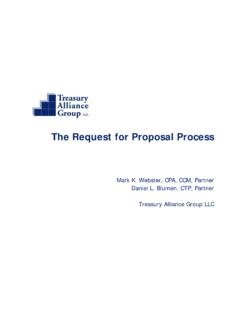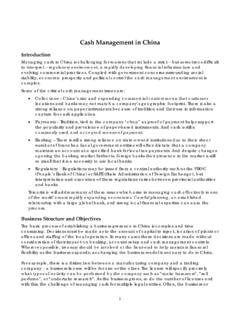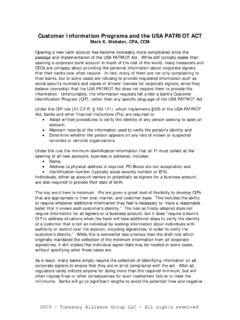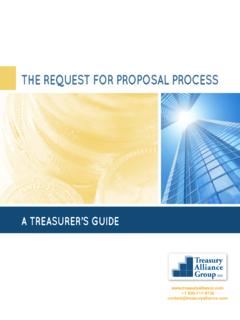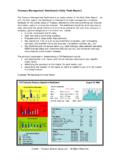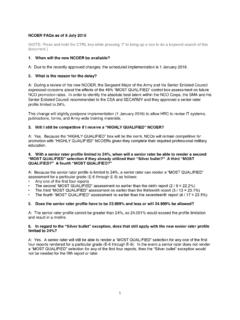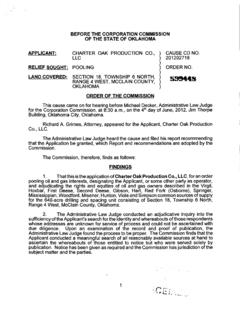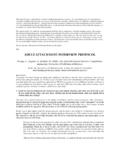Transcription of CAsh PoolinG - Treasury Alliance
1 A TreAsurer s GuideCA sh +1 630-717-9732 1 PoolinG Mechanics 3 Choosing an Approach 9 Implementation Issues 12 Tax Considerations 17summary 22CA sh PoolinG A TreAsurer s Guide 2012 Treasury Alliance Group LLC. All Rights Reserved 1inTroduCTionLiquidity management is an important Treasury objective that is challenging because of the need to juggle excess and deficit cash positions across multiple entities, regulatory environ-ments and currencies. For medium to long term cash mismatches a combination of adjust-ing capital structures via intercompany and third party lending is the best approach. For the short-term cash PoolinG the offset of deficit positions for some entities with the surplus positions of others is the tool of choice. The benefit is elegant in its simplicity: the elimination of the bid/offer spread on these funds along with improved visibility and control of cash. There are various approaches to PoolinG so understanding the definitions, options, nuances and tax implications is essential.
2 If done correctly and with support from tax counsel, imple-mentation of a PoolinG structure can yield significant ongoing benefits for the company. This paper explains cash PoolinG and identifies the issues for Treasury , tax, accounting and business BasicsThere are two ways of PoolinG cash physical and notional. In physical PoolinG funds in separate sub accounts are auto-matically transferred to/from a header or concentration ac-count in order to eliminate idle cash and fund cash outflows. The participating entities are either in surplus or deficit from a transactional perspective, but the bank accounts themselves are zero-balanced. Physical PoolinG can be used across multiple legal entities, located in the same or different coun-tries but in the same currency. The funds movement between the participating entities is accounted for via intercompany PoolinG achieves the same result, but it is accomplished by making balancing en-tries on a set of virtual accounts with no changes to the bank accounts held by company entities.
3 The bank managing the notional pool provides an interest statement that reflects If done correctly and with support from tax counsel, implementation of a PoolinG structure can yield significant ongoing benefits for the company. CA sh PoolinG A TreAsurer s Guide 2012 Treasury Alliance Group LLC. All Rights Reserved 2the net offset that and is similar to what would have been achieved with physical PoolinG . As there is no physical movement of money, intercompany loans are not required to account for the offset. This benefit is somewhat negated by strict regulatory requirements that can include the need for cross-guarantees of obligations by participating entities. Notional pool-ing can be applied on a cross currency basis, but this may further add to the complexity and will be discussed further in this following chart provides a high-level summary of the differences between physical and notional PoolinG :NotioNal PooliNgPhysical PooliNgInterest is earned/paid as bank interestCoMPensATIonMust use arm s length rate, track loans and allocate interestCan provide tax efficiencyTAxWithholding taxes can apply to inter-company loansHighly complex due to involvement of banks and multiple jurisdictionsCoMPLexITyGreater transparency generates less regulatory concernCan be implemented across multiple currenciesAPPLICAbILITyMust be done on a currency by currency basisRestricted in many countriesAvAILAbILITyWidely available and most common form of poolingCA sh PoolinG A TreAsurer s Guide 2012 Treasury Alliance Group LLC.
4 All Rights Reserved 3 PoolinG MeChAniCsnotional PoolingNotional PoolinG is best explained using the example of a hypothetical company that has three subsidiaries A, B and C operating in the UK with GBP as the functional currency. The credit interest rate offered by the London branch of the bank is and the debit rate of interest is AXyZ Bank Branch 1(75) at 4%Subsidiary BXyZ Bank Branch 2200 at 2%Subsidiary CXyZ Bank Branch 3100 at 2%Traded SeparatelyA pays 3B earns 4C earns 2 Company earns = 225A pays earns 4C earns 2 Company earns eUr 100B eUr 40C eUr (50)A eUr 0B eUr 0C eUr 0 Header AccounteUr 0 Header AccounteUr 90 Beginning Cash PositionPhysical PoolinG ResultLend to headerLend to headerBorrow from headerA, B and C enter into a PoolinG agreement with the bank and credit and debit interest rates are specified. Day-to-day banking business is conducted as usual for the separate legal entities. Daily transactions can be viewed on the bank s web platform and normal reconcili-ation takes place.
5 The benefit of notional PoolinG , as this example shows, is that while the company earned 3 on its total position without PoolinG , after PoolinG was earned through the elimination of the bid/offer spread, a benefit of GBP. This benefit is sometimes shared with the participants by the parent company as an incentive to enter into the agreement but it is not mandatory from a tax perspective. CA sh PoolinG A TreAsurer s Guide 2012 Treasury Alliance Group LLC. All Rights Reserved 4 Because of the simplicity and ease of operation, notional PoolinG is often the technique of choice for in-country, single currency pools. However, it may not be a wise selection in all countries as it may be subject to scrutiny by local tax authorities the US and Germany, for example. A basic reason for this is the arrangement may be interpreted as co-mingling of funds. Notional PoolinG is common as an in-country arrangement in the UK, Netherlands and Belgium, which have minimal, or no, withholding tax on interest earned in a PoolinG arrange-ment.
6 There may also be country-specific interpretations that require a holding company to function as the pool manager, which currently applies in the UK and PoolinG , with the virtual set of accounts the bank maintains to achieve the offset makes bank accounting for the PoolinG arrangement on its balance sheet an important mat-ter for regulatory authorities in the country where the pool operates. In some countries ad-ditional documentation, such as cross guarantees among the pool participants, may be re-quired because deficits from the PoolinG participants appear as assets on the bank s balance sheet. Because there is no interest earned on these assets they appear to be non-performing loans. To justify its accounting treatment the bank obtains guarantees that enable the right of offset and the ability to use surplus funds to cover deficit positions. The requirement for cross guarantees does not apply in the Netherlands, which serves to explain the popu-larity of the Netherlands as a location for notional PoolinG .
7 Notional PoolinG becomes more complicated when it ex-pands from a single country to a multi-country arrange-ment due to both the cross currency and cross border na-ture of the pool. When dealing with more than one currency, even within the same country, it is necessary to bring the currencies to a common base currency, often the Euro or US dollar, before the PoolinG and interest offset can take place. One technique for doing this is through a short-dated swap. Alternatively, a notional conversion to a base currency can be made with the risk covered through the adjustment of the interest rates paid or charged in each currency. Either approach makes the process more problematic and less cost effective as the bank s desire to be compensated for its risk takes place at the expense of the corporate client PoolinG its PoolinG , with the virtual set of accounts the bank maintains to achieve the offset makes bank accounting for the PoolinG arrange-ment on its balance sheet an important matter for regula-tory authorities in the country where the pool operates.
8 CA sh PoolinG A TreAsurer s Guide 2012 Treasury Alliance Group LLC. All Rights Reserved 5 The advent of the Euro did not fully mitigate the difficulties of cross-border notional PoolinG . There is the need to accommodate multiple regulatory regimes, demand deposit accounting platforms, dealing rooms and cutoff times. The traditional clearing systems, such as TARGET II, require a physical movement of cash to concentrate the Euro position in one location. Even when a pan-European bank substitutes its network for the clearing systems managing the book involves intervention and PoolingPhysical PoolinG is often referred to as zero-balancing. It can be achieved in a single country or across multiple countries where the pooled accounts are in the same currency. This type of PoolinG has a long history in the United States where until recently Regulation Q prohibited the payment of interest on demand deposits and interstate banking was not in the pool maintain their own bank accounts which are sub-accounts linked to a main or header account.
9 Participants day-to-day banking business is conducted as usual. Daily activity can be viewed on the bank s web platform and various account services for collections and disbursements can be set up separately in the sub-accounts. The header account is generally a different legal entity from the operat-ing participants and could be the parent company, depend-ing on the country of domicile. The pool header can also be held by a regional subsidiary, a finance company or any oth-er type of special purpose vehicle (SPV), shared service cen-ter (SSC) or Treasury center. The accounts are maintained in any country where PoolinG is permitted and are best located where there are efficient payment and bank systems that en-able electronic movement of money between accounts. This is an area where large network banks can be particularly competitive because moving money within a bank network through a book transfer is immediate and relatively less expensive.
10 The participants conduct their daily commercial activity, paying and receiving funds, ideally using bank accounts that are part of the pool to minimize money transfer costs. At the close of each business day all positive balances in the sub-accounts are transferred to the header account and any sub-account deficit positions are covered by funding from the header. The Physical PoolinG is often referred to as zero-balancing. It can be achieved in a single country or across multiple countries where the pooled accounts are in the same currency. CA sh PoolinG A TreAsurer s Guide 2012 Treasury Alliance Group LLC. All Rights Reserved 6overall net position is either invested or, if in deficit, funded through a centralized credit fa-cility. Cash flows between the header and the participant accounts are generally treated as intercompany loans unless all movements take place within the same legal the example of a company with multiple operations in the Eurozone.


